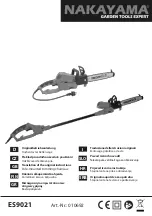
English | 15
www.ffgroup-tools.com
table (Fig. 7.A) down, bringing it to rest against
table stop.
2. Use a square (Fig. 8.A) placed on the table and
against the blade (Fig. 8.B) as shown, verify that
the table is 90˚ to the blade.
3. If an adjustment is necessary, tilt table up to ac
-
cess table stop.
4. Loosen nut (Fig. 7.D) and turn table stop in or
out to raise or lower it. Tighten the nut to secure
adjustment.
5. Tilt table back down against the stop bolt and
verify that the table is 90˚ to the blade. Tighten
table lock knob.
6. If an adjustment was made, the pointer (Fig. 7.E)
should be adjusted. Loosen pointer screw, line
up the pointer with the 0˚ mark on the scale and
retighten pointer screw.
To install / change the blade:
WARNING
Wear safety glasses to avoid being scraped if the
blade should suddenly uncoil. Wearing gloves, care
-
fully uncoil new blade by holding it at arms length.
1. Loosen the upper blade guide assembly lock
knob (Fig. 9.A) and position the upper blade
guide assembly (Fig. 9.B) about half way be
-
tween the table and the frame. Retighten the
lock knob.
2. Open the front covers by turning the cover lock
knobs counterclockwise.
3. Loosen lock knobs and pull table extension
away from table.
4. Remove rip fence guide rail.
5. Release tension on blade by moving quick re
-
lease tension lever (Fig. 11.D) to the right.
6. Remove blade (Fig. 9.C) around upper and low
-
er wheels (Fig. 9.D) and from between the up
-
per and lower blade guides (Fig. 9.B, 10.E).
7. Remove blade through slot in table.
8. Guide the new blade through table slot and
place it around the upper and lower wheels
and into the upper and lower blade guides. The
blade teeth must face the operator, and they
should point down toward the table.
9. Position the blade in the middle of the rubber
tires on the wheels.
10. Place tension on the blade by moving the quick
release tension lever to the left.
11. Reinstall the rip fence guide rail.
WARNING
Before operating the bandsaw, check that the blade
is properly tensioned and tracking properly. The
blade tension knob (Fig. 11.B) is used to adjust blade
tension. The quick release tension lever (Fig. 11.D)
must be engaged (moved to the left) before making
blade tension adjustments with the blade tension
knob.
To adjust the blade tension:
1. Disconnect the machine from any power
source.
2. Turn blade tension knob just enough to apply
tension and take slack out of blade.
3. Turn one wheel a few times to allow blade to
position itself in center of tire.
WARNING
If the blade does not center itself, see the next sec-
tion regarding blade tracking adjustment.
4. A gauge (Fig. 10.A), positioned directly behind
and above upper wheel, indicates approximate
tension according to the width of the blade.
Set blade tension with knob (Fig. 10.B) to corre
-
spond to blade width as marked on gauge.
5. Blade tracking refers to the position the blade
turns on the wheels while in motion. The blade
should track in the centre of both wheels. To
adjust the blade tracking (Fig. 11):
WARNING
The blade tension must be properly adjusted before
tracking the blade.
1. Open upper and lower doors. Rotate upper
wheel forward by hand, and observe position
of the blade on the upper wheel through the
window (A). Blade should be in the center of
the wheel.
2. If adjustment is necessary: Loosen handle (B)
and make adjustment with tracking knob (C)
while rotating wheel by hand.
3. Tightening the tracking knob slightly will move
the blade so it tracks towards the rear of the
machine. Loosening the tracking knob slightly
will cause the blade to track towards the front
of the machine.
4. After blade is tracking in the center of the
wheel, tighten handle.
The upper blade guide should be adjusted just
above the material being cut. To adjust the upper
blade guide (Fig. 12) loosen lock knob (B) and raise
or lower upper blade guide assembly (A) by turning
height adjustment knob (C). Adjustments are per
-
formed in the same manner for each blade guide
assembly. Each assembly must be adjusted in turn
using the following adjustment procedures.
To adjust the upper thrust bearing (Fig. 13.A) and
lower thrust bearing (Fig. 14.A):
1. For the upper thrust bearing, loosen lock knob
(B). For the lower thrust bearing, loosen set
screw (B).
2. Slide the adjustment shaft (C) so the blade is po
-
sitioned in the middle of the thrust bearing. The
thrust bearing is mounted on a concentric shaft.
When the shaft is rotated, the relative position
of the bearing to the back of the blade can be
changed.
3. Rotate the adjustment shaft so the thrust bear
-
ing just clears the back of the saw blade.
4. Tighten lock knob / set screw. If a blade is being
replaced with a new one of a different size, fur
-
ther adjustment may be required as follows:
5. Loosen the screw (D) with a wrench and adjust
the entire assembly back or forth to just clear
the back of the saw blade. Tighten screw, then
fine tune the adjustment by repeating the first
part of this section.
6. Secure the thrust bearing by tightening the lock
knob (B) or set screw (B).
To adjust the upper guide bearing (Fig. 13.G) and
lower guide bearing (Fig. 14.G):
1. For upper blade guide assembly, loosen the two
lock knobs (E). For lower blade guide assembly,
loosen the two set screws (E).
2. Slide adjustment shafts (F) to position each
BAS 240i PLUS
Summary of Contents for 47 877
Page 3: ...www ffgroup tools com 3 2 3 4 BAS 240i PLUS ...
Page 4: ...4 5 8 7 C A D B 6 BAS 240i PLUS ...
Page 5: ...www ffgroup tools com 5 9 10 BAS 240i PLUS ...
Page 6: ...6 12 13 11 C B A D A B C BAS 240i PLUS ...
Page 7: ...www ffgroup tools com 7 14 15 16 A B BAS 240i PLUS ...
Page 65: ......
Page 66: ...66 BAS 240i PLUS ...
















































